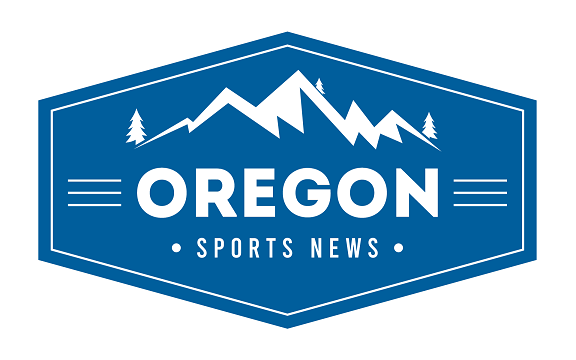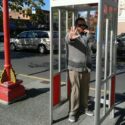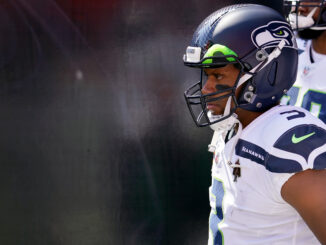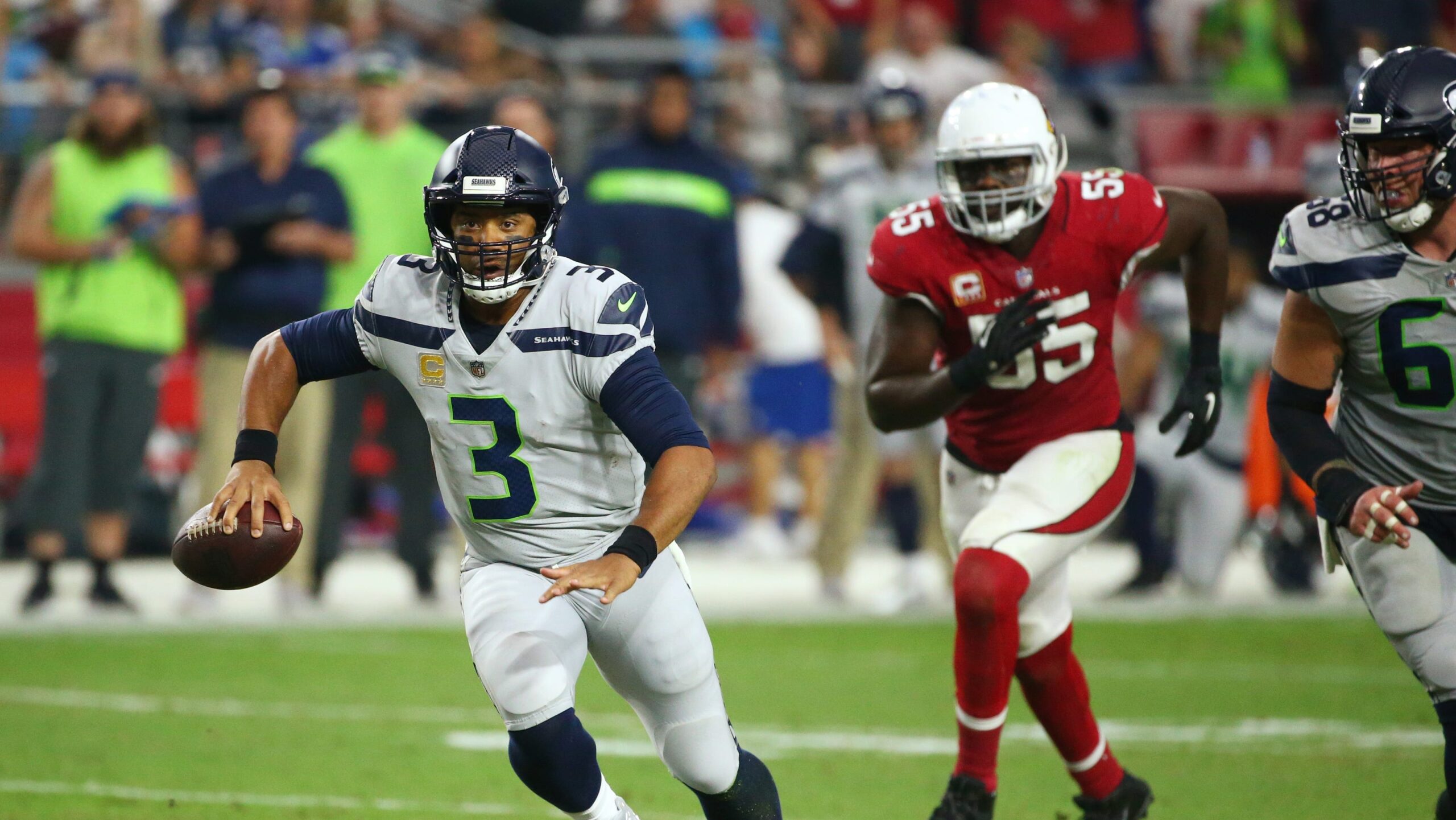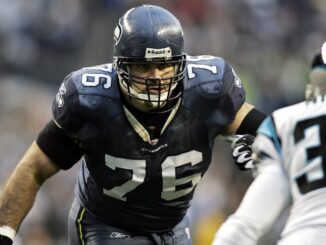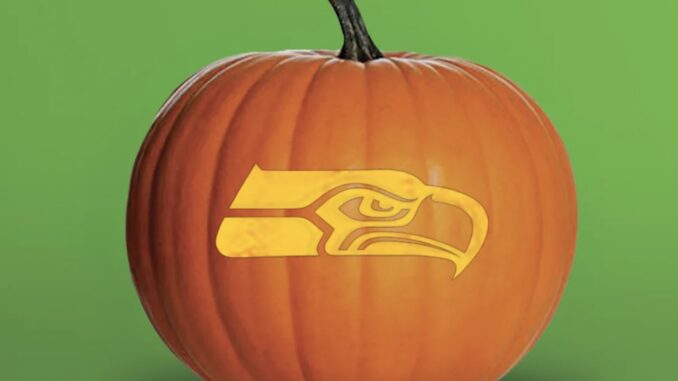
In honor of Halloween this Friday (which is not Friday the 13th for those of you who, like me, often suffer from mild traits of dyscalculia), what better way to celebrate the holiday than by taking a spooky trip down memory lane of the thirteen scariest ghosts in Seahawks’ history.
There are likely to be some that frighten all, some that frighten only a few, and others who shake their head and wonder why that moment should count as a horrific memory. But that’s the thing about fear – everyone is afraid of something, but not everyone is scared of the same things. It’s a numbers game; if you want to scare everyone, you have to produce a lot of scares, and not all of them will land.
Fear takes many shapes, not the way you always expect. And with that in mind, let’s start our journey to visit the most haunting ghosts in Seattle’s history.
Organization often helps calm the senses and provide a sense of security, so we present this list in no particular order.
2003 Wild Card
QB Matt Hasselbeck would be the full-time starter for the first time, the team would win 10 games, and they would get back to the playoffs for the first time in four seasons and just the second trip in Mike Holmgren’s time in Seattle. So, of course, they had to play on the road against Green Bay, with Hasselbeck and Holmgren facing their former team. Seattle would find a way to force overtime in Lambeau, but an unforgettable moment happened during the overtime coin toss. After Seattle won the toss, Hasselbeck famously told millions watching at home that Seattle wanted the ball and was going to score. Unfortunately, Hasselbeck’s pass was intercepted by Green Bay corner Al Harris, who returned it for a touchdown and the game-clinching score.
1983 AFC Championship
This was the Seahawks’ eighth season in the NFL, and while they had a winning record in a previous season, this was their first trip to the playoffs. Seattle finished second in the AFC West at 9-7 behind the 12-4 LA Raiders, and Seattle had defeated LA in both meetings. Seattle stormed through the first two rounds, beating the Broncos and Dolphins before meeting the Raiders in the conference championship. The Raiders had the Seahawks on the ropes all game, storming out to a 20-0 halftime lead before scoring 14 more in the second half to win 30-14 while picking off Seattle QB Dave Krieg multiple times and locking the Seahawks in a nightmare with their first trip to the Super Bowl on the line. After the loss, Seattle would not return to the conference championship again until 2005.
2005 Super Bowl
Seattle was one of the best teams in the league in Hasselbeck’s third season as the starter, and MVP RB Shaun Alexander was unstoppable behind the league’s best offensive line. The defense was more than serviceable, and the team roared to a 13-3 record and, with the NFC #1 seed, had homefield advantage throughout the playoffs. Seattle earned its first trip to the Super Bowl, where it would face the Pittsburgh Steelers, who had fought their way there as the first sixth seed to win three home games and reach the Super Bowl. Seattle played nearly perfectly on defense, forcing Steelers QB Ben Roethlisberger to record one of the worst passer ratings in Super Bowl history. Seattle almost overcame the Steelers’ defense and some extremely questionable officiating, but ultimately lost 21-10, with a potential game-shifting touchdown wiped off the board by a flag most objective folks would never have called. Seattle would not return to the conference championship or the Super Bowl for eight more years.
2006 divisional
The year after their devastating loss in the Super Bowl, Seattle earned its way back to the playoffs and was one score away from going to the conference championship in back-to-back years for the first time in team history. Despite winning the coin toss and getting the ball to start the extra period, Seattle went three and out, and a short punt landed Chicago in field goal range. Robbie Gould sent Chicago to their first conference championship in almost 30 years, and Seattle would not get past the divisional round again until 2013.
2014 Super Bowl
A year after their first title in team history, Seattle was again the NFC’s number one seed and played its playoff games at home. A wild overtime victory over Green Bay in the conference championship sent them to their second consecutive Super Bowl and third appearance in team history, this time facing the New England Patriots. Seattle was tied going into halftime, and a ten-point third quarter put them in great position in the final frame. New England took a late four-point lead, but Seattle drove to the New England five-yard line with just over a minute to play. Seattle probably could have run the ball three times, burned clock to prevent the Patriots from mounting a comeback, and let Marshawn Lynch score the game-winning touchdown. Instead, they passed, and New England intercepted it at the goal line, sealing Seattle’s fate and crushing their dream of repeating as champions. They have not made it past the divisional round of the playoffs for eleven years and counting.
Steve Hutchinson
Following their defeat in the 2005 Super Bowl and wanting a new contract, Hutch signed an offer sheet from Minnesota that would have made it very difficult to keep the rest of Seattle’s team intact. The Seahawks were forced to let their star lineman walk and didn’t get anything in return. Seattle was not the same on offense the next season and slowly fell apart as their all-star line was now a one-man show with Walter Jones having to carry a lot of lesser-talented players.
Nate Burleson
As revenge for losing Hutchinson, Seattle signed Minnesota receiver Nate Burleson to a similar deal, but the trade-off was not exactly even. While Hutchinson helped open running lanes for Adrian Peterson, for all the money he was paid, Burleson never came close to 1,000 receiving yards, and his nine scores in 2007 were a career high despite recording only 694 receiving yards. His 2007 season would be a fluke compared to his other three years in Seattle, when he averaged less than two scores per season.
Charlie Whitehurst
Before Pete Carroll brought Russell Wilson to Seattle, he made some, let’s call them questionable choices at QB in his first two seasons. After moving on from fan favorite Hasselbeck, who had just won Carroll his first playoff game over the defending champion Saints, Carroll traded a third-round pick to San Diego for backup QB Charlie Whitehurst, whom Carroll insisted was their QB of the future. I’m not sure what Carroll meant by “future,” but if he meant a guy who looked more like an out-of-work country singer than an NFL QB, then I guess he got his wish. “Checkdown Charlie” and “Clipboard Jesus” became nicknames for Whitehurst, as he hated taking deep shots downfield and often served as the reserve QB holding the clipboard. He started four games for the Seahawks over two seasons before returning to San Diego in 2012.
Cardinals Destroy The Legion of Boom
A few years after they won their first Super Bowl in team history, Seattle had to say so long to the key players who the team arguably would have never made it that far without their help. While it looked like cold, business decisions by a team known for being player-friendly, it was, in fairness, a horrible run of bad luck. Richard Sherman would suffer an Achilles injury in 2017 against Arizona, and the team would release him before he signed with the rival 49ers. A neck injury in the same game in which Sherman was injured would have derailed Kam Chancellor’s career, and he would never play again, being released in 2019 after sitting out 2018. Earl Thomas would break his leg against the Cardinals the following season and would sign with Baltimore as a free agent in 2019.
Aaron Curry
Selected fourth overall in 2009, Seattle passed on roughly ten Pro Bowl players in the first round to choose Curry. Only appearing in 35 total games in three seasons, Curry was traded to the Raiders for a seventh-round pick and is widely considered one of the biggest busts in team history despite many experts calling him the best linebacker and a safe pick going into the draft. If Seattle had its heart set on a linebacker, Brian Orakpo, Brian Cushing, and Clay Matthews all were taken after Curry in the first round and had more impressive careers.
Koren Robinson
Seattle held two first-round picks in the 2001 draft thanks to trades with Green Bay and Dallas in previous seasons. They used the second of their two picks on Steve Hutchinson, which was a great move, but their taking Robinson at #9 and passing on 15 really good players to take him will make him one of the biggest busts in team history. For reference, Chad Johnson went early in the second round, and Santana Moss and Reggie Wayne were selected late in the first. Robinson had a very promising second season in Seattle, recording 1,200 yards and 5 touchdowns, but never came close to those numbers again and was playing for Minnesota by 2005.
Max Unger
Almost like a straight-to-video horror movie sequel that no one knows why was made, in the year following their brutal loss in the Super Bowl to the Patriots, Seattle traded Unger (who was the strength of their offensive line) to New Orleans for tight end Jimmy Graham. Believing they needed a player to counter the receiving threat of Rob Gronkowski, whom they had just faced and should have beaten, Seattle sent Unger and a first-round pick in a lopsided deal that derailed their dynasty. The running game fell apart, Russell Wilson struggled to carry the offense, and the team never returned to the league-leading efficiency they showcased every week with Unger at center.
Deion Branch
Following their loss in the 2006 playoffs, Seattle was looking to reload and get their offense back on track. While receiver was not precisely a primary concern, they made one of many questionable choices in a series of them to close out the decade, as they sent a first-round pick to New England for receiver Deion Branch. In just over four seasons in Seattle, Branch never had a 1000-yard season or recorded more than four touchdowns in a season. Branch never played a full season in Seattle and was traded back to New England for a 4th round pick in the 2011 draft. Seattle used the pick to select outside linebacker KJ Wright, who would be a critical part of their 2013 and 2014 Super Bowl teams. While the trade helped derail their late 2000s title hopes, at least they helped another generation, even if it did lead to more ghosts as well.
